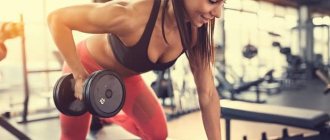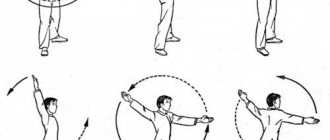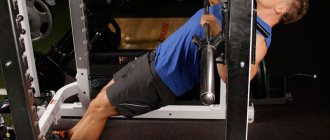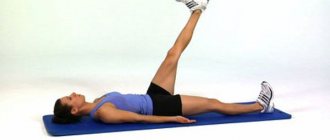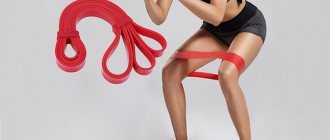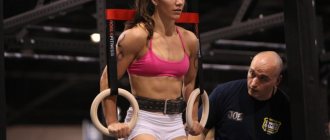The sequence of exercises in the gym for girls and men, its strict implementation is very important. Any professional clearly knows how to manage the order of actions and frequency in order to either load or unload a specific muscle group. Using this knowledge, an athlete, even a non-professional, will be able to competently create a training program for himself, improve his results and reach a higher level in bodybuilding.
In order to decide on the order and achieve the desired results without spending extra time, you need to know what types of exercises exist and what groups they are divided into. These skills are necessary in order to prevent injuries that are sure to occur from ignorance of the subject.
The exercises performed in the gym are divided into two large groups:
- Basic (works a group of joints)
- Isolating (one joint works).
Basic ones include training that involves large muscle groups, several joints, requiring maximum concentration and tension of the whole body. They are very effective at building body mass and are the basis of strength training.
Isolating - working with one muscle group, usually where only one joint works. This allows you to work more precisely on a specific area of the body.
What are basic and isolated exercises?
BASIC EXERCISES - the second name is multi-joint, when 2 or more muscles are involved in the work, and the main load is placed on 1 large one.
ISOLATED EXERCISES - the second name is single-joint, 1 muscle is involved in the work and the emphasis of the load is on it.
Many beginners do not want to do basic exercises, inventing different reasons, but there is only one reason - THIS IS NOT THE DESIRE TO DO THE BASIC, BECAUSE IT IS HARD! Therefore, they bomb the muscles exclusively in isolation, and then they wonder why there is no point.
Basic exercises set the growth and general shape of the muscles, while isolated ones tighten problem areas and make “cosmetological” correction of the figure.
Only rough basic exercises allow you to build strength and mass.
Ways and methods of performing strength exercises
For beginner athletes, it is best to stick to a traditional strength-building and muscle-building regimen. In this case, regular sets are suitable - the rest between elements and the actual approaches is from 2 to 6 minutes. For experienced athletes, more complex methods of performing exercises open up:
- Drop sets. During the training process, the athlete gradually reduces the working weights in the exercise. Reducing each time by about 25%. This way we slowly reach failure. Rest between sets is minimal.
- Supersets. They involve working out certain muscle groups (identical or opposite) by sequentially performing various exercises (two or more). There is no rest between approaches.
- Trisets. One of the varieties of a superset, which involves pumping muscles not with two, but with three exercises performed in succession. There is also no rest.
Interesting fact. Using various methods makes it possible to always keep muscles in good shape, avoiding unpleasant stagnation and the plateau effect.
Basic exercises for gaining mass
Breast:
• Bench press (in horizontal and inclined versions - head down and up); • Dumbbell bench press (in horizontal and inclined versions - head up and down); • Push-ups (the body is slightly tilted forward, do not straighten your arms at the top point, your elbows are slightly moved away from the body); • Pushups.
Back:
• Deadlift; • Pull-ups; • Bent-over rows of barbells and dumbbells; • Pulldown of the upper block to the chest; • Bench horizontal row (reverse bench press, but with your head down and the weight pulled toward your chest or waist). • Pulling the block to the belt; • Bent-over dumbbell row.
Legs:
• Squats (with a barbell, dumbbells, kettlebells, plates, or even with a girl on your shoulders); • Leg press; • Hack squats; • Deadlift on straight legs; • Lunges (no matter what sports equipment you use); • Raising on your toes (standing or sitting - load on the calves).
Deltas (shoulders):
• Bench press; • Barbell chest press; • Seated dumbbell press; • Barbell row to the chin.
Biceps:
• Standing biceps curl; • Lifting dumbbells for biceps while sitting - standing; • Hammer dumbbell curl (activates the brachioradialis muscle).
Triceps:
• Bench press with a narrow grip; • Push-ups (keep your body strictly straight, arms are fully straightened at the top point, elbows move strictly along the body).
How to properly build muscles in the gym. Training program for a beginner
For many beginners, going to the gym for the first time is a real stress. There are a lot of strange simulators that don’t know what they pump and it’s not clear how to use them. What to do? You can contact a trainer or ask more experienced visitors. But if you are afraid, then we asked Alexey Zakharov, coach of the premium club World Class Red Side, for you.
The fitness trainer explained how to use the most important equipment for a beginner and put together an effective training program for your first trip to the gym.
Get back in shape: 5 Instagram beauties that will make you go to the gym
Owners of ideal forms charge with motivation.
Fitness equipment and exercises
Seated horizontal press
Exercise to develop chest muscles. What muscle groups work
: Primarily the pectoralis major muscle, as well as the triceps and anterior deltoid.
Execution technique:
During any pressing exercise, the shoulder blades must be constantly retracted at any point in the movement. It is important to control the load on the pectoral muscle and not press with your shoulders or triceps. Make sure that the angle between the shoulder and the body is 80 degrees, that is, slightly less than a right angle.
Vertical row from above (imitation pull-ups)
Exercise for the back muscles. What muscle groups work
: latissimus dorsi muscles, biceps help
Technique:
Squeeze your shoulder blades so that the load is on your back. Breathe correctly: exhale with effort, that is, when you pull towards yourself, when moving backwards, inhale.
Overhead press
Exercises to develop shoulder muscles. What muscle groups work:
deltoid: front, side and back, triceps and upper chest help.
Technique:
squeeze your shoulder blades together and breathe correctly. Due to the fixed trajectory of movement into the simulators, other errors are unlikely.
Front thrust
Exercises to develop back muscles. What muscle groups work:
upper back muscles, rhomboids, rear deltoids, biceps helps.
Technique:
it is important to keep your shoulder blades retracted and breathe correctly.
Triceps trainer
Isolated triceps exercise. What muscle groups work:
triceps
Technique:
you need to fix your arm at the shoulder and extend it at the elbow, without including your back.
Biceps trainer
Isolated biceps exercise. What muscle groups work:
biceps
Technique:
you need to fix your arm at the shoulder and bend it at the elbow, without including your back.
Leg press
Leg exercise. What muscle groups work:
anterior and posterior thighs and gluteal muscles.
Technique:
keep your lower back pressed, the main weight rests on your heels, try to activate your gluteal muscles. It is important not to straighten your knees all the way so as not to lock the knee joint.
How to train
For a beginner, it is ideal to perform all these exercises in one workout, that is, to train the whole body at once. It is better to arrange the order in such a way that you train antagonist muscles in turn, that is, alternate between chest and back, flexors and extensors. At the end of the workout, you can add abdominal exercises: 3-6 sets of 15-20 repetitions. To develop the cardiovascular system, you can add cardio 1-2 times a week, but if the goal is to gain muscle mass, you shouldn’t do a lot of cardio.
This program can be followed for 6-8 months, gradually increasing the weight. After 6 months of completing this program, you can begin to work with free weights and include barbell squats and deadlifts in the program. At the same time, it is important to eat properly and have time to recover, as well as get enough sleep.
How many reps to do:
aim for 12-15 repetitions per set. Perform 3 sets of each exercise. Select the weight so that it is heavy, but at the same time you can perform all the repetitions with the correct technique.
How much to train:
For a beginner, it is better to do exercises for all muscle groups. Train 3 times a week for 40-60 minutes, so your body will have time to recover, but at the same time not lose tone and is constantly in the process of building muscle mass.
Calisthenics before and after. How to get pumped up without going to the gym
You no longer need a gym membership and we'll tell you why.
How Emelianenko got rid of his belly. The best abdominal exercises from an MMA fighter
The heavyweight boasted about his abs and told how he achieved the result.
Superhero training. 3 exercises of 100 repetitions every day
A Singaporean got pumped up in 100 days using a training program from a cartoon. You can do this too.
The order of performing exercises (muscle compatibility)
Here we will describe an example of the correct sequence of muscle loading during a workout, that is, when performing a basic exercise (back, chest, legs), the isolated muscles are not affected, you then load them fresh:
Scheme No. 1
Back – triceps – abs Chest – biceps – forearms – abs Legs – shoulders – abs
You can choose a different scheme, but remember that when doing it, the muscles are involved in basic exercises and will be a little tired, so the weight will have to be reduced a little, and this may affect strength and mass, for example:
Scheme No. 2
Back – biceps – rear deltoids Chest – triceps – anterior deltoids Shoulders – triceps
In most cases, use the first scheme, at least in the initial stages of training, and then when you gain experience, you will experiment yourself and choose the best option for yourself.
Subscribe to groups on social networks (VKontakte, Odnoklassniki, Facebook, Twitter, Yandex Zen), it’s very easy to find us, just write Bomb body in the search for the desired group!
Exercise routine in the gym
It is generally accepted that bodybuilding training should begin with basic (multi-joint) exercises and end with isolating (single-joint finishing exercises).
I talked about the difference between basic and isolation exercises in this article. Read it, it's small.
This sequence is easily explained by the fact that in order to grow muscle mass, an increase in strength is necessary. You won't see a truly big bodybuilder constantly lifting tiny weights in the gym, because if the load doesn't increase, then there's no point in the muscles getting bigger, because... muscles are very energy-consuming things. It's simple here. As the load increases, the muscles grow.
In what cases can you start with isolation exercises?
Sometimes it will be advisable to start training with isolation exercises, thereby changing your order of exercises in the gym. The main thing is that you pursue a clear goal!
So, you can start your isolation training:
- When your working weights are heavy enough that there is an increased risk of injuring ligaments or joints (as these are the “weak links” involved in heavy movements), and you need to pre-fatigue the muscles with isolation exercises. This way you additionally load the muscles and do not give them the opportunity to lift as much as usual, and also remove excess load from the “weak links”.
- When your muscles are still sore from a previous workout and this prevents you from training properly. You can warm up a little with light weights, and also add 10-15 minutes of cardio on an exercise bike or treadmill.
But still, as a rule, training begins with basic exercises, as well as with LARGER MUSCLES.
Large muscle groups are:
- legs;
- back;
- breast;
Triceps exercises
Reverse push-ups
Stand with your back to the bench, rest your palms on it with your straight arms, your feet resting on the floor, and the rest of your body suspended in the air. Bend your elbows and lower your hips down, then begin to return to the starting position. Reverse push-ups not only work the triceps, but also the upper pecs.
French bench press
Lie on a horizontal bench, feet resting on the floor, and buttocks and shoulder blades pressed to the surface. The barbell is positioned at arm's length above chest level. Then, while inhaling, lower the projectile behind your head, bending your elbows. You should feel your triceps working and stretching.
On the abdominal muscles
Plank
One of the most wonderful exercises that harmoniously works the abdominal muscles, back, and back of the thigh. Lie down on a gymnastic mat, bend your arms at the elbow joint. Transfer your body weight with your arms and feet bent, your back, head and legs forming a straight line.
Hold this position for 30 seconds or longer.
Other variations of the exercise: plank on one hand, plank with alternating hands, plank with one leg raised.
Side crunches
Lie on a horizontal mat, legs bent at the knees, hands behind your head. Connect your right elbow to your left knee, doing a twist, then vice versa. Perform the exercise at a fast pace to get a good feel for the work of all the abdominal muscles.
Back exercises
Deadlift
One of the best basic exercises that perfectly works the back muscles, gluteal muscles, hamstrings, strengthens the lower back and uses the arms. It allows you to develop all muscle groups proportionally.
To perform a deadlift, stand up straight, hold a bar with weights in your hands, your legs are set narrowly, your back is absolutely straight, your knees are bent quite a bit. Slowly lean forward, the bar seems to slide along your legs, maintaining a deflection in the lumbar region. Having reached the lowest point, stay there for a couple of counts and rise up again.
An easier version of the deadlift is performing the exercise with dumbbells. His technique is similar to the previous version, only instead of a barbell in his hands there are dumbbells.
Bent-over barbell row
Bent-over rows help build beautiful and harmonious shoulder and back muscles. To perform a row, bend your knees at an angle of about 10 degrees and place your feet shoulder-width apart, grab the bar with your arms extended downwards and bend at an angle of about 30 degrees, while looking forward. As you inhale, pull the barbell straight to your stomach, and as you exhale, lower it again to your outstretched arms.
Be careful to only pull the bar with your latissimus dorsi and not with your arms. Your elbows must be strictly fixed, and your back should not be slouched under any circumstances.
Shoulder exercises
Army press
Sit on a horizontal bench, back straight, feet resting on the floor. Hold dumbbells in both hands, bend your elbow and lift the dumbbells to shoulder level. Now, as you exhale, press the dumbbells up until they stop, then return to the starting position. Please note the following points:
- The back is perfectly straight all the time;
- The elbows move along a strictly defined trajectory;
- At the highest point, the dumbbells are very close.
Dumbbell lateral raises
Stand straight, feet together, take dumbbells with the required weight in both hands. As you exhale, bend your elbows slightly and then spread your arms out to the sides until they are parallel to the floor. Pause at the highest point and slowly lower the projectile down. Watch the position of the lumbar region and back, it should remain straight all the time!
Biceps exercises
Close grip pull-ups
When doing pull-ups, several muscle groups are involved in the work at once: all the back muscles and biceps. To perform this, grab the bar with an overhand grip, with your hands at a distance of 3-4 cm from each other.
Pull yourself up with your arms and back, bending your elbows until your head is above the bar. Then lower yourself down the same way.
The exercise can be greatly facilitated if you perform it in a gravitron, where you can place a small counterweight.
On the leg muscles
Leg press
An excellent basic exercise that will help evenly work all the lower muscles. Sit in a bench press machine with your back and head pressed against the support, your knees bent and your feet on the platform. As you exhale, press the platform all the way, then bend your knees again and lower the platform.
If you want to focus on the gluteal muscles, then place your feet on the upper edge of the platform, and if on the quadriceps, then on the lower edge.
Squats
One of the best basic exercises that evenly engages the back muscles, glutes, legs and abs. Place your feet approximately shoulder-width apart, with your toes facing outward, and your back completely straight. Take the bar with weights and place it on your shoulders, holding it with your hands, squat down, and then stand up again.
During a squat, your knees should not go beyond your toes, your back should remain straight at all times. Also make sure to squat to parallel with the floor or slightly lower.
